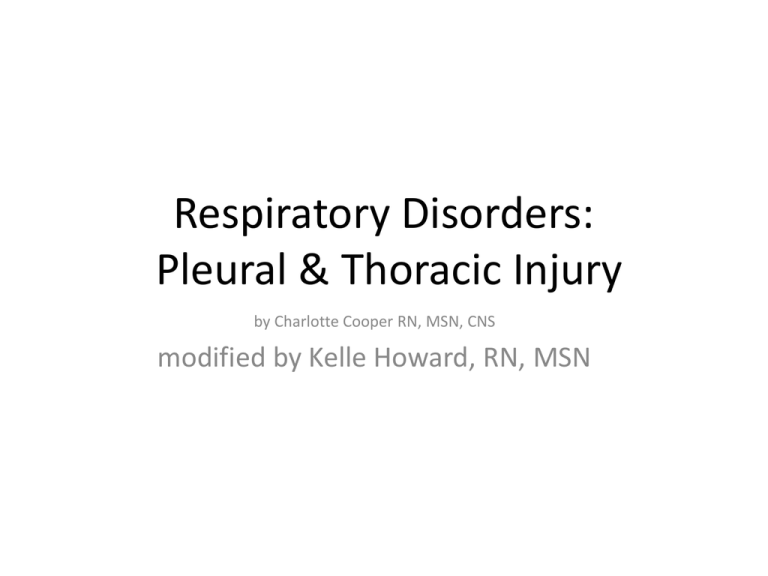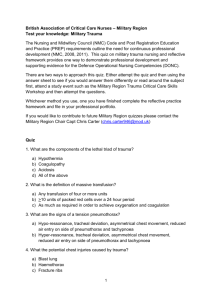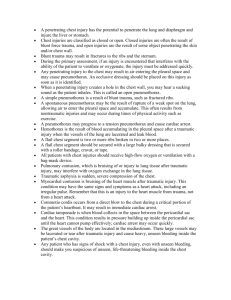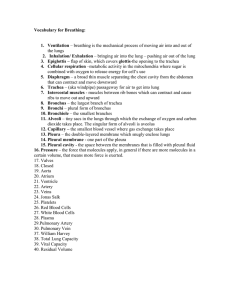PowerPoint
advertisement

Respiratory Disorders: Pleural & Thoracic Injury by Charlotte Cooper RN, MSN, CNS modified by Kelle Howard, RN, MSN Thoracic Cavity http://www.google.com/imgres?imgurl=http://www.tcnj.edu/~mckinney/body.jpg&imgrefurl=http://www.tcnj.edu/~m ckinney/breathing.htm&h=480&w=460&sz=60&tbnid=7I0hIqYYrrrEDM:&tbnh=129&tbnw=124&prev=/images%3F q%3Dthoracic%2Bcavity&usg=__64_qfRrbnmkZHJsDtcpsNyDQUk=&ei=HjqESrfvF4eosgPnloGqBw&sa=X&oi=image_result&resnum=4&ct=image 2 Normal Anatomy • • • • Thoracic cavity Chest wall Pleural space Fluid 3 Terminolgy • Pleura – the thin serous membrane around the lungs and inner walls of the chest (2 layers) • Pleural space – thin space between the 2 layers of pleura • Pleural cavity – body cavity that surrounds the lungs • Parietal Pleura – Pleura that lines the inner chest walls and covers the diaphragm • Viceral Pleura – Pleura that lines the lung itself • Pleural Fluid – pleura that lines the inner chest wall and covers the diaphragm Pleural Fluid • • • • • • pH 7.6 – 7.64 1-2g/dL protein Less than 1000 WBC per cubic millimeter Glucose level similar to plasma LDH less than 50% that of plasma Na, K+, & Ca levels similar to that of interstitial fluid • Viceral pleura – – Covers surface of the lung – Cannot be disected away from the lung • Parietal pleura– Lines the wall of the chest and covers the diaphragm http://www.themesotheliomalibrary.com/pleural-effusions.JPG Chest Trauma & Thoracic Injury • 20-25% of trauma victims with chest trauma die • 45% of trauma victims have some type of chest trauma • BEWARE: External injury may appear minor 7 Categories for Traumatic Injuries • Blunt trauma • Penetrating trauma Traumatic Chest Injuries Mechanism of Injury Blunt Trauma Blunt steering wheel injury to chest Common Related Injury Rib fractures, flail chest, pneumothorax, hemopneumothorax, myocardial contusion, pulmonary contusion, cardiac tamponade, great vessel tears Shoulder harness seat belt injury Fractured clavicle, dislocated shoulder, rib fractures, pulmonary contusion, pericardial contusion, cardiac tamponade Crush injury (heavy equipment, crushing the thorax) Pneumothorax and hemopneumothorax, flail chest, great vessel tears and rupture, decreased blood return to heart with decreased cardiac output Penetrating trauma Gunshot, stab wound to chest Open pneumothorax, tension pneumothorax, hemopneumothorax, cardiac tamponade, esophageal damage, tracheal tear, great vessel tears 9 Respiratory Disorders: Pleural and Thoracic Injury • Pleural Effusion • A collection of excess fluid in the pleural space • Classification • Transudative causes aka: hydorthoraces ----- systemic – Usually not caused by inflammatory processes – Most common type • Exudative ----- localized cause – Usually caused by an inflammatory process – Often recurrent, difficult to treat 10 Empyema • What is it? • What causes it? • How do we treat it? Etiology: Pleural Effusion Identify the Class of Effusion Disease Process Classification of Effusion Heart Failure TB Lupus/RA Renal Disease Lung Cancer Trauma Pneumonia Liver Failure 12 Other Types • Hemothorax • Chylothorax Clinical Manifestations: Pleural Effusion • • • • • Dyspnea Pleurisy Decreased breath sounds Decreased chest wall movement Dullness on percussion 14 15 How do we diagnosis pleural effusions? Pleural Effusion -- Diagnositcs • • • • ____________ ____________ ____________ ____________ How do we know what type of pleural effusion it is? Interventions: Pleural Effusion • Thoracentesis Diagnostic vs. Therapeutic 19 Interventions: Pleural Effusion 20 Thoracentesis • What are your nursing responsibilities pre & post thoracentesis? – ______________ – ______________ – ______________ – ______________ – ______________ – ______________ Interventions: Pleural Effusion Chest tube placement/ PleurX catheter 22 Interventions: Pleural Effusion Treat underlying condition CHF/Renal failure Pneumonia Liver Disease Lupus/RA Malignancy Pleurodesis Chest tube insertion Allow to resolve 23 Complications of Pleural Effusion • Trapped Lung • Recurrent effusions • Pneumothorax PNEUMOTHORAX • 3 types – Closed – Open • aka? __________________ – Iatrogenic Closed Pneumothorax No opening from external chest. Open Pneumothorax Opening from external chest wall into pleura. Iatrogenic Pneumothorax Puncture or laceration of visceral pleura during medical tx Occurs in crashes, falls, MVAs, CPR, COPD, fractured ribs that penetrate the pleura. Occurs in stabbings, gunshot wounds, impalement injury. Occurs in central line placement, thoracentesis, lung biopsy, bronchoscopy, & mechanical ventilation, central line placement 26 ww http://images.google.com/imgres?imgurl=http://graphics8.nytimes.com/images/2007/0 8/01/health/adam/15210.jpg&imgrefurl=http://www.nytimes.com/slideshow/2007/08/01/ health/100150Pneumothoraxseries_4.html&usg=__VZn79dHtqdr7izJf1jBM0r5R4ig=&h =320&w=400&sz=44&hl=en&start=3&sig2=06HaoI7v1pH1SPxnpU_4Vg&um=1&tbnid =l0LTfAdhVxUVSM:&tbnh=99&tbnw=124&prev=/images%3Fq%3Dblebs%2Bon%2Blu ngs%2Bcausing%2Bpneumothorax%26hl%3Den%26rlz%3D1T4DMUS_enUS282US2 82%26sa%3DN%26um%3D1&ei=lGWJSvXaGIawtAOVxtidBw Clinical Manifestations: Pneumothorax • Describe what you would see: – Respiratory – Cardiac 28 Tension Pneumothorax • Air/blood/fluid rapidly entering the pleural space • Lung collapses • Emergency situation 29 Pathophysiology: Tension Pneumo Increase in intrapleural pressure Compression of lung Compresses against trachea, heart, aorta, esophagus What is this called? Ventilation and cardiac output greatly compromised __________________________ 30 Clinical Manifestations: Tension Pneumo • • • • • • • • Severe dyspnea Tracheal deviation Decreased cardiac output Distended neck veins Increased respiratory rate Increased heart rate Decreased blood pressure Shock 31 Treatment Tension Pneumo • Emergency --- quick intervention – Needle decompression – Chest tube placement Intervention: Pneumothorax • • • • • • High Fowlers position Oxygen as ordered Rest to decrease oxygen demand ***Chest tube insertion Pleurodesis Surgery ? 33 Clinical Manifestations: Rib Fractures • • • • • • Ribs 5-10 most commonly fractured Pain Splinting & rapid, shallow respirations Decreased breath sounds Crepitus Signs/symptoms of pneumothorax 34 Treatment: Rib Fractures • • • • Reduce or minimize pain Do we wrap or bind the chest? Do we use opiods? Goal? Pathophysiology: Flail Chest • 2 or more ribs fractured • 2 or more separate places • Unstable / free floating chest • Usually involves anterior or lateral fx • Paradoxical respirations 36 Clinical Manifestations: Flail Chest • Dyspnea with rapid, shallow inspiration • Pain • Palpable crepitus • Decreased breath sounds • Unequal chest expansion • Tachycardia 37 Interventions: Flail Chest • • • • • • • Oxygen as ordered Elevate HOB Analgesia Suction Splint affected side? *Intubation *Mechanical ventilation • What do you think the major goals are? 38 Pathophysiology: Pulmonary Contusion Abrupt chest compression then rapid decompression Intra-alveolar hemorrhage Interstitial/bronchial edema Decreased surfactant production Increase pulmonary vascular resistance Decrease blood flow 39 Clinical Manifestation: Pulmonary Contusion • • • • • • • • • Increased SOB Restlessness Anxiety Chest pain Copious sputum Increased respiratory Increased heart rate Dyspnea Cyanosis 40 Intervention: Pulmonary Contusion • • • • • • Intubation Mechanical ventilation Bronchoscopy Fluids Volume expanders Pulmonary artery pressure monitoring 41 Chest Surgeries Lewis 573 Table 28-24; NCP 28-2 • Exploratory thoracotomy – Incision into thorax to look for injured or bleeding tissue • Thoracotomy not involving lung • VATS – Video-assisted thoracic surgery to do lung biopsy, lobectomy, ect





